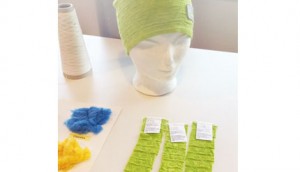 A senior committee that represents Finland bio-economy sector visited Istanbul and Ankara in 2 – 5 February 2015.
A senior committee that represents Finland bio-economy sector visited Istanbul and Ankara in 2 – 5 February 2015.
The leading companies of Finland came together at a meeting held in 3 February in Istanbul with the representatives of public and private sectors and they promoted a new technology. Companies such as VTT Technical Research Center of Finland, Stora Enso Oyj, Metsä Fibre Oy and NIS Cluster Oy introduced an environment friendly and cost efficient brand new technology that is used to create textile tissue from paper cellulose called as soluble cellulose to the Turkish industry and public sector. Experts from both countries discussed the opportunities regarding this new technology in a joint meeting in Istanbul, where paper and cellulose, soluble cellulose and textile industries are represented. The presentations of Finnish committee were given by the Vice President of VTT Technical Research Center of Finland Prof. Johanna Buchert and Research Professor Prof. Ali Harlin. After the meeting, Finnish committee got together with the Turkish paper, cellulose and textile industries’ representatives and discussed about the cooperation opportunities between Turkey and Finland in the field of bio-economy. Committee representatives had the chance of meeting with Finland European Affairs and Foreign Trade Minister Lenita Toivakka, Minister of Economy Nihat Zeybekçi, Minister of Forestry and Water Affairs Veysel Eroğlu and TOBB (Turkish Union of Chambers and Commodity Exchanges) Vice President Çetin Osman Budak. Committee representatives, who also had meetings with the Turkish companies, stated that they expected even higher business volumes thanks to these new opportunities between Finland and Turkey within the scope of JETCO agreement signed between the two countries.
SOLUBLE CELLULOSE TECHNOLOGY
Did you know that your clothes were made from wood based raw materials? You have probably come across with the word “viscos” written on the washing labels of your clothes. Viscos is a textile fiber made from wood just like Rayon, Modal and Lyocell.
JOURNEY FROM TREE TO SOLUBLE CELLULOSE
Soluble cellulose, which is the raw material of regenerated fibers, can be produced from many types of trees. Finnish supplier Stora Enso uses white birch for this. In other countries soluble cellulose can be also produced from other types of trees such as eucalyptus. The production process of soluble cellulose is very similar to the production of cellulose for paper: lignin and extracts are taken from the debarked and thinned trees. Afterwards, the wood of the tree is cooked chemicals, washed, bleached and dried. The main differentiation is the extraction of the existing sugars that is the hemicellulose with big amounts via pre-hydrolysis. The final product is a pulp with high purity that has the same chemical qualities with cotton.
SOLUBLE CELLULOSE AS AN ALTERNATIVE RAW MATERIAL TO COTTON
Urbanization, usable income and shopping culture increase the demand for textile in the world. The main textile fibers are fossil based synthetic fibers such as textile fibers and cotton. It does not seem possible to increase the cotton plantation significantly in a global sense. Therefore, it is important to have natural textile fibers that carry similar characteristics with cotton. Wood based textiles principally are made from the soluble wood pulp that is soluble, bendable and regenerated as textile fiber. In addition to completing the main fiber material, regenerated fibers provide the opportunity to partially substitute for cotton or fiber based textiles. Since wood textile fibers are renewable and sustainable, the production of these fibers does not block the agricultural production. Viscos production process that is currently used undergoes many changes toward more environment friendly techniques.
Growing cotton necessitates big amounts of water: with the water needed to produce 1 kilogram cotton, it is possible to produce more than 26 kilograms of regenerated wood textile fiber. While the cultivatable areas gradually decreasing, the demand for food is increasing dizzily. Cotton agriculture today is conducted in the areas that can be used for food production. The example blow shows the probabilities relating to soluble cellulose very well: The annual growth of forests in Finland is 100 million square cubes and this amount is 40 million square cubes more than the amount of consumption. If only the half of this surplus of wood production can be used to substitute for cotton in the form of soluble cellulose, this situation will enable the cotton fields to be used for the food production that will be sufficient for 20 million people.
SOLUBLE CELLULOSE SUPPLIERS IN FINLAND
Stora Enso’s Enocell factory in Finland produces soluble cellulose. Another Finnish company providing most of the soft wood pulp to Turkey, Metsa Fibre is planning on establishing a cellulose production facility with 1.3 million capacity and working on other bio materials produced from wood such as textile fibers.
USING SOLUBLE CELLULOSE IN TEXTILE SECTOR
Soluble cellulose, which is formulated to be used in the textile industry, is later turned into regenerated cellulose fiber by subjecting it to dissolution and regeneration process through different chemicals. Cellulose-derived is transferred into an intermediate grade sulphuric acid via a nozzle. Cellulose formed yarns are neutralized, washed and dried. Later, this creates a cotton-like – silk-like fluffiness that is cut, textured and turned into wool yarn. For this dissolution – regeneration process, alternative options, from soft wool to hard silks such as Ryon, Cupro, Viscos, Modal and Lyocell with which different quality fiber materials are produced, are developed. These regenerated fibers can be used in different textile products (fashion and clothing, interior decoration and life, technical textiles etc.).
CELLULOSE CARBAMATE CCA TECHNOLOGY
Because some of the currently used cellulose regeneration processes are not sustainable, more environment friendly processes are researched by FIBIC, Finnish Forest Cluster, Technical Research Center of Finland (VTT) and Aalto University. The examples of these processes are Cellulose carbamate CCA, Bio Selsol and Ioncel-F. One of the newest opportunities in this field is the usage of textile wastes as raw material for the production of regenerated cellulosic fibers. The observed characteristics of the textile materials made from regenerated cellulosic fibers are very good and show similarities with cotton or silk in many cases. Viscos and Lyocell are commercial products that are already used. However, in order to meet the increasing demand of sustainable textile fibers, VTT further developed the chemical efficiency of the cellulose carbamate (CCA) technology. VTT currently has the opportunities to produce viscos fibers in laboratory measurement such as evaluating new raw materials and developing Bio Selsol process. Cellulose carbamate mainly aims the industry that currently uses viscos such as Rayon-fiber and Selofan film producers, who search for clean and environment friendly production techniques and who work close with the industrial work partners within pulp and cellulose derivative sectors.









